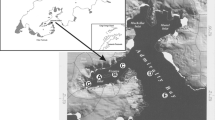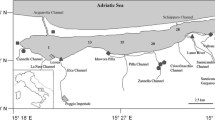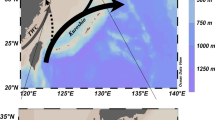Abstract
Temporal variations in water mass properties and the composition of phytoplankton pigments in the central part of Sagami Bay were investigated by monthly observations from June 2002 to May 2004. Eleven pigments were quantified using high-performance liquid chromatography (HPLC) from 100%, 20%, and 5% light depths relative to the surface; the class-specific composition of phytoplankton community was then obtained by CHEMTAX analysis. The study area was influenced by the Kuroshio water for most of the observation period. The mean contribution of diatoms in all samples was relatively low (29%), while that of flagellates, mainly chlorophytes or cryptophytes, was quite high (60%). The phytoplankton composition at the three depths was uniform throughout the observation period, indicating that the vertical structure of the phytoplankton community did not develop significantly over time. A distinct temporal pattern was observed: flagellates dominated during the summer of 2002 and the winters of 2002–2003 and 2003–2004, while diatoms dominated during the summer of 2003. This pattern was associated with water mass changes. The community in the summer of 2003 was influenced by coastal water. While no distinct spring bloom of phytoplankton was observed, a weak increase in chlorophyll a was observed during the spring of 2004. Ocean color satellite data showed that fluctuations in chlorophyll a concentrations at time scales much shorter than a month occurred during the spring of 2003 and that the elevations in chlorophyll a levels were not continuous. The fluctuations were probably associated with rapid flushing by the Kuroshio water, which has low chlorophyll a content.
Similar content being viewed by others
References
Furuya, K. and R. Marumo (1983): The structure of phytoplankton community in the subsurface chlorophyll maxima in the western North Pacific Ocean. J. Plankton Res., 5, 393–406.
Furuya, K., K. Takahashi and H. Iizumi (1993): Wind-dependent formation of phytoplankton spring bloom in Otsuchi Bay, a Ria in Sanriku, Japan. J. Oceanogr., 49, 459–475.
Furuya, K., M. Hayashi and Y. Yabushita (1998): HPLC determination of phytoplankton pigments using N, Ndimethylfolmamide. J. Oceanogr., 54, 199–203.
Furuya, K., M. Hayashi, Y. Yabushita and A. Ishikawa (2003): Phytoplankton dynamics in the East China Sea in spring and summer as revealed by HPLC-derived pigment signatures. Deep-Sea Res. II, 50, 367–387.
Gibb, S. W., D. G. Cummings, X. Irigoien, R. G. Barlow and R. F. C. Mantoura (2001): Phytoplankton pigment chemotaxonomy of the northeastern Atlantic. Deep-Sea Res. II, 48, 795–823.
Gieskes, W. W. C. and G. W. Kraay (1983): Dominance of cryptophyceae during the phytoplankton spring bloom in the central North Sea detected by HPLC analysis of pigments. Mar. Biol., 75, 179–185.
Gieskes, W. W. C., G. W. Kraay, A. Nontji, D. Setiapermana and D. Sutomo (1988): Monsoonal alternation of a mixed and a layered structure in the phytoplankton of the euphotic zone of the Banda Sea (Indonesia): A mathematical analysis of algal pigment fingerprints. Neth. J. Sea Res., 22, 123–137.
Goericke, R. and D. J. Repeta (1992): The pigments of Prochlorococcus marinus: The presence of divinyl chlorophyll a and b in a marine procaryote. Limnol. Oceanogr., 37, 425–433.
Hashimoto, S., N. Horimoto, Y. Yamaguchi, T. Ishimaru and T. Saino (2005): Relationship between net and gross primary production in the Sagami Bay, Japan. Limnol. Oceanogr., 50, 1830–1835.
Hooks, C. E., R. R. Bidigare, M. D. Keller and R. R. L. Guillard (1988): Coccoid eukaryotic marine ultraplankters with four different HPLC pigment signatures. J. Phycol., 24, 571–580.
Iwata, S. (1985): Physics. p. 401–409. In Coastal Oceanography of Japanese Islands, ed. by Coastal Oceanography Research Committee, the Oceanographical Society of Japan, Tokai University Press, Tokyo (in Japanese).
Jeffrey, S. W. (1997): Preparation of chlorophyll standards. p. 207–238. In Phytoplankton Pigments in Oceanography, ed. by S. W. Jeffrey, R. F. C. Mantoura and S. W. Wright, UNESCO, Paris.
Jeffrey, S. W. and S. W. Wright (1994): Photosynthetic pigments in Haptophyta. p. 111–132. In The Haptophyte Algae, ed. by J. C. Green and B. S. C. Leadbeater, Clarendon Press, Oxford.
Jeffrey, S. W. and S. W. Wright (1997): Qualititative and quantitative HPLC analysis of SCOR reference algal cultures. p. 343–360. In Phytoplankton Pigments in Oceanography, ed. by S. W. Jeffrey, R. F. C. Mantoura and S. W. Wright, UNESCO, Paris.
Kamatani, A., N. Ogura, N. Nakamoto, M. Funakoshi and S. Iwata (1981): Distribution of nutrients in Sagami Bay during 1971–1973. Bull. Japan. Soc. Sci. Fish., 47, 1493–1498.
Kanda, J., S. Fujiwara, H. Kitazato and Y. Okada (2003): Seasonal and annual variation in the primary production regime in the central part of Sagami Bay. Prog. Oceanogr., 57, 17–29.
Kawabe, M. and M. Yoneno (1987): Water and flow variations in Sagami Bay under the influence of the Kuroshio path. J. Oceanogr. Soc. Japan, 43, 283–294.
Kutsuwada, K., M. Tanikawa, Y. Hagiwara and T. Katsumata (2007): Long-term variability of upper oceanic condition in Suruga Bay and its surrounding area. Oceanogr. Japan, 16, 277–290 (in Japanese with English abstract).
Legendre, L. (1990): The significance of microalgal blooms for fisheries and for the export of particulate organic carbon in oceans. J. Plankton Res., 12, 681–699.
Lindell, D. and A. F. Post (1995): Ultraphytoplankton succession is triggered by deep winter mixing in the Gulf of Aqaba (Eilat), Red Sea. Limnol. Oceanogr., 40, 1130–1141.
Longhurst, A. (1998): Ecological Geography of the Sea. Academic Press, San Diego, 398 pp.
Mackey, M. D., D. J. Mackey, H. W. Higgins and S. W. Wright (1996): CHEMTAX—a program for estimating class abundances from chemical makers: application to HPLC measurements of phytoplankton. Mar. Ecol. Prog. Ser., 144, 265–283.
Mackey, M. D., H. W. Higgins, D. J. Mackey and S. W. Wright (1997): CHEMTAX user’s manual: a program for estimating class abundances from chemical markers—application to HPLC measurements of phytoplankton pigments. CSIRO Marine Laboratories Report 229, Hobart, Australia, 41 pp.
Mackey, D. J., H. W. Higgins, M. D. Mackey and D. Holdsworth (1998): Algal class abundances in the western equatorial Pacific: Estimation from HPLC measurements of chloroplast pigments using CHEMTAX. Deep-Sea Res. I, 45, 1441–1468.
Moore, L. R., R. Goericke and S. W. Chisholm (1995): Comparative physiology of Synechococcus and Prochlorococcus: influence of light and temperature on growth, pigments, fluorescence and absorptive properties. Mar. Ecol. Prog. Ser., 116, 259–275.
Nurjaya, I. W., Y. Kitade, M. Matsuyama and S. Matsui (1999): Distribution of low saline water near the mouth of Tokyo Bay. La mer, 37, 1–10.
O’Reilly, J. E., S. Maritorena, D. A. Siegel, C. O’Breien, D. Toole, B. G. Mitchell, M. Kahru, F. P. Chavez, P. Strutton, G. F. Cota, S. B. Hooker, C. R. McClain, K. L. Carder, F. Muller-Karger, L. Harding, A. Mangnuson, D. Phinney, G. F. Moore, J. Aiken, K. R. Arrigo, R. Letelier and M. Culver (2000): Ocean color chlorophyll a algorithms for SeaWiFS, OC2 and OC4: Version 4. p. 9–23. In SeaWiFS Postlaunch Calibration and Validation Analyses, Part 3. NASA Tech. Memo., 2000-206892, Vol. 11, ed. by S. B. Hooker and E. R. Firestone, NASA Goddard Space Flight Center, Greenbelt, Maryland.
Partensky, F., W. R. Hess and D. Vaulot (1999): Prochlorococcus, a marine photosynthetic prokaryote of global significance. Microbiol. Mol. Biol. Rev., 63, 106–127.
Repeta, D. J. and T. Bjørnland (1997): Preparation of carotenoid standards. p. 239–260. In Phytoplankton Pigments in Oceanography, ed. by S. W. Jeffrey, R. F. C. Mantoura and S. W. Wright, UNESCO, Paris.
Shapiro, L. P. and E. M. Haugen (1988): Seasonal distribution and temperature tolerance of Synechococcus in Boothbay Harbor, Maine. Estuar. Coast. Shelf Sci., 26, 517–525.
Strickland, J. D. H. and T. R. Parsons (1972): A practical handbook of seawater analysis. Bull. Fish. Res. Bd. Can., 167, 310 pp.
Suzuki, R. and T. Ishimaru (1990): An improved method for the determination of phytoplankton chlorophyll using N,Ndimethylfolmamide. J. Oceanogr. Soc. Japan, 46, 190–194.
Ting, C. S., G. Rocap, J. King and S. W. Chisholm (2002): Cyanobacterial photosynthesis in the oceans: the origins and significance of divergent light-harvesting strategies. Trends Microbiol., 10, 134–142.
Valiela, I. (1995): Marine Ecological Processes. Springer-Verlag, New York, 686 pp.
Veldhuis, M. J. W. and G. W. Kraay (1990): Vertical distribution and pigment composition of a picoplanktonic prochlorophyte in the subtropical North Atlantic: a combined study of HPLC-analysis of pigments and flow cytometry. Mar. Ecol. Prog. Ser., 68, 121–127.
Zapata, M., F. Rodríguez and J. L. Garrido (2000): Separation of chlorophylls and carotenoids from marine phytoplankton: a new HPLC method using a reversed phase C8 column and pyridine-containing mobile phases. Mar. Ecol. Prog. Ser., 195, 29–45.
Author information
Authors and Affiliations
Corresponding author
Rights and permissions
About this article
Cite this article
Hashihama, F., Horimoto, N., Kanda, J. et al. Temporal variation in phytoplankton composition related to water mass properties in the central part of Sagami Bay. J Oceanogr 64, 23–37 (2008). https://doi.org/10.1007/s10872-008-0002-8
Received:
Revised:
Accepted:
Issue Date:
DOI: https://doi.org/10.1007/s10872-008-0002-8




